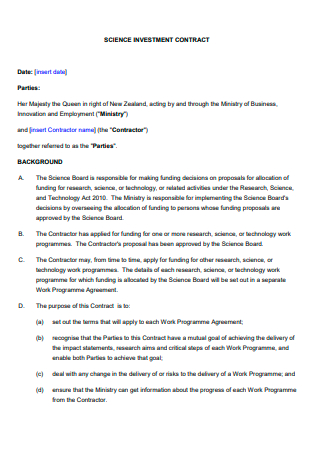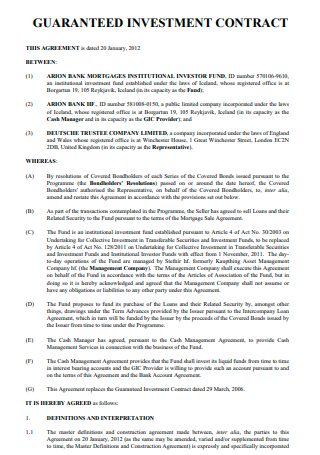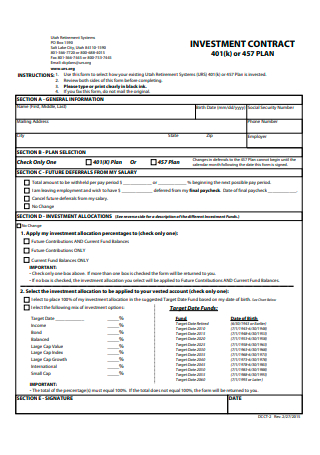FREE Formal Investment Contract s to Download
A formal investment contract refers to an agreement, transaction, or scheme in which a person invests money in a joint venture and is persuaded to believe that profits would be generated primarily through the labor of others. According to statistics, only about 20% of investment professionals are successful investors. Success could be defined as generating returns comparable to or greater than the market’s average earnings.
Benefits of Investing
A well-diversified investment portfolio can assist you in achieving your long-term financial plans. For instance, save for retirement, pay off your mortgage early, or pay for your children’s college tuition. While savings accounts provide convenient access and the security of guaranteed funds, the profits on these accounts are often low. Over the long run, investing in the inventory market might generate enormous profits but higher risk. If you’re still considering investing, here are some of the advantages.
Possibility of long-term returns: While cash is safer than stocks, it is dubious about expanding significantly or discovering growth prospects in the long run. Historically, investors have reaped profits over the long run through investments that include some degree of capital risk. This entails the possibility of losing some or all of the money you initially invested. Naturally, these benefits are not insured. Volatility in the stock market, described as rapid changes in stock values over a short time, is not always a bad thing. Indeed, volatility can occasionally provide investment managers with an opportunity to purchase appealing stocks at a discount and earn a higher rate of return in the long run.Surpass inflation: Your savings must yield a rate of return after taxes considerable than the inflation rate to grow in real terms over time. With today’s low-interest rates, finding a savings account that offers a rate of return more than the current inflation rate can be challenging. As a result, it’s worthwhile to examine investments with the potential to outpace inflation.Maintain a steady income: If you’re old or on the point of retirement, you’re undoubtedly looking for something that will provide you with a steady income to meet your daily living expenditures. There are a variety of investments available, including shares, bonds, and real estate, that can give a steady stream of income that is frequently larger than the rate of inflation.Adapt to your changing requirements: You or an Investment Manager can tailor your investment portfolio to meet different objectives as you progress through life. For example, you may want lower-risk investments as you age. You may modify your portfolio to match changing goals and priorities with proper planning. Suppose you intend to invest for a lengthy time. In that case, you may like to invest in growth funds, risky areas such as emerging markets, or private equity, where your savings can weather short-term market fluctuations. You may want to consider more income-oriented investments if you’re about to retire.Invest according to your financial situation: As your financial circumstances change, you can adjust your investment strategy to meet your needs. You can invest lump sums as and when you can or set up a monthly investment plan with smaller recurring payments. If you have the funds available, you can immediately begin investing. The earlier you invest, the more time your money has to grow. Alternatively, investing a consistent amount each month can help smooth out market volatility, especially in a volatile market.Investing Can Assist You in Tax Savings: Another HUGE perk of investing is the potential for tax savings! If you’d like to pay taxes now, you can use a retirement account such as a ROTH IRA. This option requires you to pay tax now and not need you to pay tax upon withdrawal. These are merely elementary examples. The tax code contains numerous loopholes that benefit investors. This is how the wealthy maintain their wealth while paying so little in taxes! Suppose you’re looking to reduce your tax liability. In that case, I strongly advise you to consult with your CPA or Financial Advisor to create a customized investment strategy that meets your unique circumstances.Invest To Achieve Additional Financial Objectives: Additionally, you can consider investing to assist your money to grow to fulfill other financial goals. Consider contributing to your child’s college fund. When you have a ten-year or longer-term goal, investing that money to help you achieve it faster may make sense! There are numerous advantages to investing. If you want to achieve financial stability, expand your wealth, and save for retirement, you must develop a customized investing strategy.Tech Savy: The younger generation is technologically literate, researching, studying, and applying internet investing tools and approaches. Online trading platforms, chat rooms, and financial and educational websites offer fundamental and technical research chances. Technology, such as online opportunities, social media, and applications, can contribute to a young investor’s information base, experience, confidence, and skill.Human Capital: Human capital can be conceived as the present value of all future incomes from an individual’s standpoint. Because the ability to earn a living is necessary for investing and saving for retirement, investing in oneself—whether through a degree, on-the-job training, or advanced skills—is a worthwhile investment that can yield significant returns. Young individuals frequently have numerous options to enhance their future earning potential, and taking advantage of these opportunities might be regarded as one of the multiple forms of investing.
Tips Before Investing
You may be considering whether you should make changes to your investment portfolio in light of recent market happenings. While we cannot instruct you on how to handle your investment portfolio in a volatile market, we supply you with the information necessary to make an informed decision. Consider the following critical aspects before making any decision:
Create a financial road map for yourself: Before making any investment plans, sit down and conduct an honest assessment of your whole financial condition – especially if you’ve never created a financial plan before. The first step in having effective investing is determining your investment objectives and risk tolerance – either independently or with a financial advisor. There is no assurance that your assets will provide a profit. However, obtain the facts about saving and investing and implement an educated plan. You should be able to achieve financial security over time and reap the rewards of money management.Evaluate your risk-taking comfort zone: Each investment entails some level of risk. If you intend to purchase securities – stocks, bonds, or mutual funds – you must understand the risk of relinquishing some or all of your money before investing. You risk losing your principal or the amount invested. This is true even if you invest through a bank. The possibility for a higher asset return is the prize for taking on risk. If you have a long-term financial purpose, you will likely earn more money by carefully investing in higher-risk asset classes, such as stocks or bonds, rather than limiting your investments to lower-risk assets. On the other hand, investing exclusively in cash may benefit short-term financial objectives. Individuals investing in cash equivalents are primarily concerned with inflation risk, which is the danger that inflation will outstrip and erode earnings over time.Consider an acceptable portfolio composition: By combining asset classes with variable investment returns that fluctuate in response to market conditions, an investor can help safeguard against substantial losses. Historically, the returns on the three primary asset classes – stocks, bonds, and cash – have not fluctuated in lockstep. Market dynamics that favor one asset class frequently result in an asset class earning just ordinary or negative returns. By investing in multiple asset classes, you lower the chance of losing money and smooth the ride of your portfolio’s total investment results. If the investment return on one asset class falls, you’ll be able to offset your failures in that asset category with increased investment returns in another asset category. Also, asset allocation is critical since it significantly impacts your ability to achieve your financial goals. If you do not have enough risk in your portfolio, your investments may fail to provide a sufficient return to satisfy your objective. For instance, if you’re saving for a long-term goal, such as retirement or college, the majority of financial experts say that your portfolio should include at least some stocks or stock mutual funds.Be cautious while investing extensively in your employer’s or any other stock: Diversification is a critical component in mitigating investment risks. It’s self-evident: avoid putting all your eggs in one basket. By selecting the appropriate subset of assets within an asset class, you may be able to limit your losses and reduce investment return volatility without losing too much potential gain. If you invest extensively in your employer’s stock or any individual stock, you expose yourself to enormous financial risk. If the store performs poorly or the company declares bankruptcy, you will almost certainly lose a substantial amount of money.Consider cost averaging in terms of dollars: By following a consistent pattern of counting new money to your investment, you may protect yourself against the risk of investing all of your money at the wrong time using the investment strategy known as “dollar-cost averaging.” You will purchase more of an investment when its price is low and negligible of an asset when it is high if you make regular investments with the same amount of money each time.
How To Write an Investment Contract
Receiving financing is a joyous occasion for any fledgling business. Typically, it takes a lot of effort to locate the ideal investor. It is critical to have an investment contract that safeguards all parties’ interests when you do so. The investor will want to ensure that his investment is protected. The company will want to ensure that funds are supplied efficiently and that the founders’ share in the enterprise is protected.
-
1. Create the Investment Contract’s Opening Recitals
The recital should include the date of the agreement’s execution, as well as the names and addresses of the contract’s parties. If applicable, use the firm name and address, as the corporate contact will be specified later in the agreement.
2. Formulate your “Whereas” and list the Agreement’s Articles
This indicates that the first company is looking for cash for its endeavor, and the second company is willing to provide the funding. A “hence” statement should follow this. “Therefore, in regard of the covenants and promises described subsequently, the parties agree as follows:” is a common expression. Furthermore, the articles contain everything previously discussed and agreed upon but written down as part of the contract.
3. Take note of the Investment Contract’s payment terms.
These terms vary for each company and frequently rely on the size of the investment. Occasionally, an investment is made in the form of a lump sum payment; in this case, the amount of the transfer, the agreed-upon date, and the receiving bank statement information should be included. When an investment is made in multiple installments, it is prudent to refer to an attachment that details the dates and amounts of each payment into the receiving bank account.
4. Identify any deliverables and the contract’s term and termination
Often, investments involve the achievement of specified benchmarks by specific dates or the development of new products due to firm activity. These are referred to as deliverables. Include a list of the investment contract’s deliverables, along with their respective due dates. The phrase refers to the duration of the agreement’s validity, which is essentially the time during which the investor makes the financial commitment and receives the agreed-upon return on investment (ROI). The termination clause specifies how the agreement will be terminated and how the parties can opt-out of the contract early.
5. Show the Investor and Company Contacts and Explain the Law Selection
This section of the investment contract should include both firms’ names, titles, addresses, telephone numbers, fax numbers, email addresses, and recommended contacts. Also, because the legislation varies slightly by place, it is critical to specify which state would have jurisdiction over the agreement.
6. Execute the Contract
Each party must sign the contract in the presence of two witnesses. Also, each witness must sign the contract. Ideally, one witness should be a Notary Public capable of notarizing the signatures, but this is not required. Sign two documents of the agreement, one for each party’s records.
FAQs
How are investors compensated?
Typically, investors are compensated in proportion to their equity in the business or the percentage of the company they possess based on their investment. This can be done strictly based on the amount they have or through what are known as preferred payments.
The majority of shareholders’ agreements will specify the number of shares each party holds and the amount invested in the business. Typically, the contract will determine who will work for the firm and conditions, with all shareholders normally eligible to serve as directors.
Are investors compensated on a monthly basis?
Investors are frequently easier to locate than lenders, and terms can be modified or updated as needed—monthly installment payments to the investor. Determine a reasonable monthly payment depending on the percentage of the business being sold and the revenue generated by the company the previous year.
Is Bitcoin a security?
The SEC’s initial coin offerings might be regarded as an investment contract and security. The tokens being issued reflect an investment of money in a joint company with reasonable anticipation of profit from the efforts of others.
The investment process can consume significant time, resources, and effort, particularly for those responsible for document management and meeting coordination. However, the outcome is well worth the cost. Entrepreneurs and partners must ensure that everyone is compensated adequately, from business proposals to property investment plans. Indeed, investments aid in the development of a business. Therefore, develop investment strategies and identify potential collaborators.




